Last updated: May 17, 2021
Article
Preserving the Texaco Road Map Pavement at the New York State Pavilion
Article from the proceedings from Are We There Yet? Preserving Roadside Architecture and Attractions, April 10-12, 2018, Tulsa, Oklahoma. Watch a non-audio described version of the presentation on YouTube.
After the Fair: Preserving the Texaco Road Map Pavement at the New York State Pavilion
By John Hinchman, Amel Chabbi, and Annie Thorkelson
The Architectural Conservation Laboratory, School of Design, University of Pennsylvania
Abstract
In 1964 the largest map pavement since the 6th century Madaba floor mosaic was realized by famed American architect Philip Johnson for the New York State Pavilion at the New York World’s Fair. Known as the “Tent of Tomorrow,” the twelve-story open-air elliptical pavilion became the symbol of the fair and for its main floor, Johnson designed a 130-foot by 166-foot terrazzo replica of a Texaco New York state paper road map. Capturing the spirit, creativity, and dynamism of the 1960s, the map was among the first large-scale Pop art monuments for public consumption and it became an immediate cultural icon that married the nation’s automobile culture and one its most popular symbols-the great American road map-with the ancient tradition and technique of terrazzo. Today it is one of a handful of artworks to survive from the fair in situ despite its poor condition.
A comprehensive documentation and model conservation program was developed in 2006-2008 through a grant from the National Endowment for the Arts. The materials and techniques of fabrication were researched, and existing conditions were recorded allowing a detailed GIS based analysis of performance and deterioration leading to a prioritized assessment and pilot treatment program. Intervention considerations have addressed the performance and deterioration issues of modern materials used in a tradition manner (opus signinum). Of equal concern has been the issue of how to present this Pop art pavement as an aged or renewed work. Technical treatment issues have included research and testing on a wide range of intervention materials and methods including cleaning, injection grouting, reinforcement, and infill materials.
The Texaco map pavement project addresses the many traditional and unorthodox problems related to the conservation and presentation of large-scale modern works. As a pavement and monumental work of art symbolic of America’s love affair with the automobile and car culture, the map now must be reconsidered as its condition and significance challenges its interpretation, display, and use as a central component in the preservation of the Pavilion and the development of Corona Park, Flushing Meadows.

Introduction
The 1964-1965 New York World’s Fair was an event of unprecedented size and expectation that would come to symbolize the paradoxes of a decade that celebrated the culmination of post-war optimism and the beginning of America’s cultural and political revolution. Recognizing the new global realities in its theme, “man in a shrinking universe,” the fair celebrated global commerce and consumption through its myriad of national and international pavilions and exhibits. The New York State Pavilion, designed by American architect Philip Johnson with partner Richard Foster and engineer Lev Zetlin, was praised by both visitors and critics for its innovative technology and engaging design. The Pavilion was conceived as a complex of three components including the ‘Tent of Tomorrow’, three ‘Astro-View’ observation towers (the tallest reaching 226 feet), and the ‘Theaterama,’ the latter designed to display art of the American avant garde, and in particular, the Pop art movement. The Pavilion was a superlative structure in all ways; not only was it the tallest and the largest state building at the fair, but it possessed the largest cable suspension roof of its type-a bicycle wheel roof, the largest slip-cast concrete columns to date, and the world’s largest two-dimensional map. With less than serious references to flying saucers and a yellow and red-stripped circus tent, Johnson’s New York State Pavilion embodied the same pop culture references that informed the Pop art works showcased on the walls of the Theaterama. The staggering attendance figures for the Pavilion are a testament to its popularity: by the close of the second season in 1965, an estimated six million fairgoers had passed through its gates and walked upon the famous map floor.
Like most structures at the fair, the Pavilion was designed to be temporary and was to be demolished after the close. Nevertheless, the Pavilion was one of several structures selected to remain, partly due to its design excellence and the exorbitant cost of demolition. While the Theaterama was renovated into a theater for the arts in 1972 (and again in 2007-08), attempts to transform the Tent of Tomorrow into a roller skating rink in the 1970s ultimately failed and the structure, falling into disrepair, was eventually closed in 1976. Today it remains a beloved landmark, especially for New Yorkers, despite its ruinous condition. Johnson himself remarked on more than one occasion that he thought it would make a fine ruin.[1]
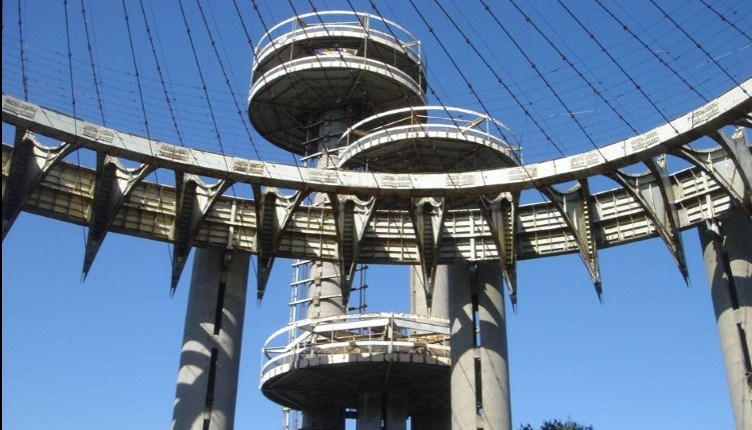
The Great Texaco Floor Map
One of the most popular attractions at the Pavilion’s ‘Tent of Tomorrow’ was its terrazzo pavement incorporating an enormous Texaco road map of the state of New York. Following ancient precedents in depicting the world as a pavement, Johnson updated the tradition and imagery by selecting one of the most ubiquitous of American pop culture symbols-the road map-and utilized modern materials never before employed in terrazzo such as colored glass aggregates and plastic insets. Enlarged to monumental proportions, the Texaco map symbolized the country’s love-affair with the automobile and the consumer society celebrated at the fair. In addition to its size, the pavement was also the most extensive terrazzo project ever undertaken, costing approximately a million dollars to complete. Rand, McNally & Company supplied the topographic information, while Texaco provided the location of each of its state gas stations.
The map pavement was an instant success. Fairgoers interacted with the giant map locating themselves across its vast geography. Like the Tent itself, the Texaco map pavement was another example of Johnson’s brilliant use of American pop symbol. As such it is one of the first and largest public Pop art monuments in the United States.[2] Long neglected and hidden from public view since the 1970s, the pavement as well as the Pavilion itself present unusual and difficult conservation challenges in preserving the recent ephemeral past.
The University of Pennsylvania’s Architectural Conservation Laboratory (ACL) has promoted the preservation of the New York State Pavilion since 2003 through a series of research efforts.[3] The following describes a two-year project to study the fabrication and survey and assess the conditions of the pavement and to develop a conservation program for the map. The project has included research into methodologies for the detailed recording of large-scale pavements, the technology of past and current terrazzo production, and the identification and testing of treatment options for several individual tiles. While this methodology was developed in response to the enormous scale of this project, it has subsequently been applied with great success to other large-scale pavements including the oldest known mosaic pavement at Gordion, Turkey.[4]
Conservation Philosophy
From the onset of the project, it was decided that the map pavement should remain an integral component of the building regardless of pavement condition or the ultimate re-use of the structure. It was also decided that the treatments should attempt to preserve as much of the original fabric as possible, given the one-of-a kind hand-made nature of the map, and to structurally and visually reintegrate the design with compatible yet discernible materials and techniques. The ultimate question was whether the pavement could continue to serve as a functional floor or if its condition would necessitate its display as an exhibit within the Pavilion. Damage to the pavement after years of exposure and deferred maintenance has left it quite fragile, which in turn has limited the options for repair and reuse. The uneven surface of the map pavement caused collectively by the deterioration of the structural support and the erosion of the terrazzo is impossible to correct and the majority of the tiles are too fragile and irregular to undergo the traditional techniques of resurfacing typically used by terrazzo companies to restore floors.
Additionally, the aged appearance of the pavement is an important component of its 44-year history. There is an interesting contradiction between the weathered appearance of the pavement and its relative youth. It is more akin to an ancient pavement in appearance, than suggested by its age and image as an innovative work of Pop art from the 1960s. Conservators who work on ancient pavements are faced with many of the same technical challenges of loss, cracking, deformation, and detachment. The ultimate approach taken for the conservation of the terrazzo map has utilized similar materials and methods developed for the conservation of ancient mosaics; however, the degree of visual compensation was extended given the availability of the original prototype (the printed map) and the necessity for cartographic legibility.
Pavement Design and Construction
The twenty-two thousand square foot map is made of 567 4’x 4’ terrazzo tiles complete with cartographic imagery, including all of the roads, town names, and Texaco gas stations in the state. Three-quarter inch sections of the original map were enlarged sixty-four times and projected to create templates for each tile. Yale University art students drew the projected map sections onto paper templates, which were then used to make plywood pattern boxes. Plastic insets representing roads, letters and symbols were fastened to the plywood bottom with metal supports and the pattern boxes were sent to Port Morris Tile and Marble Corporation, New York City, where pigmented terrazzo was poured into each section. True to cartographic norms, the roads are represented in black, red, and blue; bodies of water are light blue; landmasses, parks, and cities are represented in white, yellow, and green; and grey is used for areas outside the limits of New York State. The cast panels of terrazzo were encased in steel frames and each 400-pound panel was laid individually on a bed of reinforced concrete and sand and installed in situ using suction cup lifts. The steel frames were interlocked forming a gigantic “mosaic” of tiles.
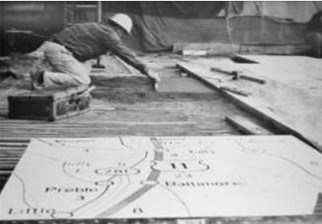
Terrazzo Design and Fabrication
Terrazzo is a composite material poured in place or precast as panels, which is used predominately for floors and other surface treatments. It consists of chips of marble, quartz, granite, glass or other aggregate with a cement or (now) epoxy binder and often pigments for additional color. Terrazzo is cured, ground and usually polished to a smooth surface to produce a durable and artistic surface. Terrazzo has a long and rich history that dates back to over fifteen hundred years. It is derived from the Roman technique of opus signinum, a simple type of mosaic pavement based on a mortar of lime, volcanic sand (pozzolana) or brick dust, and crushed marble, and inserted with isolated mosaic tesserae. The technique was later revived by the Venetians in the late fifteenth century as Pavimento alla Veneziana or later Palladiana, named after the famous Venetian architect Palladio, who frequently used the material in his villas. Small random pieces of white or colored marble waste chips from slab marble processing ranging between ½ - 2 inches were mixed with mortar and poured, ground and polished to create a durable, light-weight floor. It was one of the first known composite products made from recycled materials.
Terrazzo was introduced to the United States in the late nineteenth century, although earlier isolated examples exist from the eighteenth century such as at Mount Vernon. Terrazzo flooring along with mosaic pavements became popular by the 1920s with the introduction of improved technical processes including electric polishing and the use of new materials such as Portland cement and brass or zinc divider strips to control cracking and outline decorative designs. Immigration from Italy brought many skilled artisans to the United States during this period, among them terrazzo and mosaic craftworkers. The functional and decorative possibilities of terrazzo as well as its durability made it the material of choice for many public buildings including shops, restaurants, hotels, and government offices. Today terrazzo remains a highly versatile and durable material for floors, walls and even as individual works of art as found in almost every major airport terminal in the country.
Traditional terrazzo installation is divided into two major types: bonded and unbonded. In bonded systems, the topping and underbed are adhered to the subfloor, while in unbonded systems, the topping and underbed float on a sand bed that separates the topping and under-bed from the sub floor. Bonded installations are divided into four categories including thin set, bonded underbed, monolithic and chemically bonded, while unbonded methods are simply called “floating” or “sand cushion.”
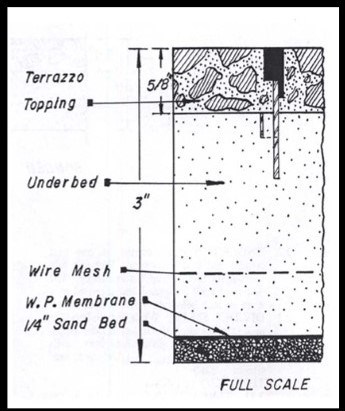
The sand cushion method of terrazzo installation separates the terrazzo topping and under-bed from the structural slab; the layer of sand helps to absorb any movement and ameliorate cracking. According to The National Tile and Terrazzo Association, the minimum thickness for a sand cushioned installation is 2 ½” but is commonly installed with at least a 3” thickness. The requirement includes a minimum ½” but more typically a 5/8” thick terrazzo topping, on a 1 7/8” thick reinforced underbed is provided. The underbed typically contains wire mesh reinforcement and sits on an isolating, waterproof membrane placed on top of the sand layer, overlapping by at least 4 inches. Divider strips are set in the underbed before the terrazzo topping is poured at a maximum distance of 6 feet, and the terrazzo is leveled to the height of the strip. The layer of sand in the unbonded method prevents structural movement in the slab that may be caused by shrinkage, expansion, settlement, or vibration. This type of installation is generally less susceptible to cracking than the other terrazzo systems.
The New York State Pavilion terrazzo is based on the unbonded sand cushion method; however, the makers took liberties with regard to the thickness of the terrazzo layer and under-bed and utilized individual tiles rather than a direct pour on site. This latter innovation was no doubt necessitated by the time constraints during construction. Each tile is 2” thick and consists of a 5/8” terrazzo topping, bonded to a 5/8” cementitious under-bed, which sits on plywood, which has been bolted to a steel frame that supports and edges the terrazzo tile. The three layers--the topping, under-bed and plywood-- are contained within the metal frame and the height from the bottom of the frame to the terrazzo surface is 2”. The plywood was likely ½” to 5/8” thick. The “L” shaped metal frame conceals the under-bed and plywood base on all four sides and holds the plywood on the bottom. The “L” shaped metal frame measures 1” x 1” x ⅛” in thickness and supports the bottom and sides of the tile. The tiles rest on a sandy concrete slab that was poured during the Tent’s construction. Underneath the “L” shaped metal frame, on the bottom of all the tiles, are protruding metal locks measuring 1” x ½” x ⅛”, and corresponding grooves in neighboring tiles that are designed to link the tiles together in a tongue and groove detail. A thin elastomeric gasket separated each tile frame and allowed for thermal movement.
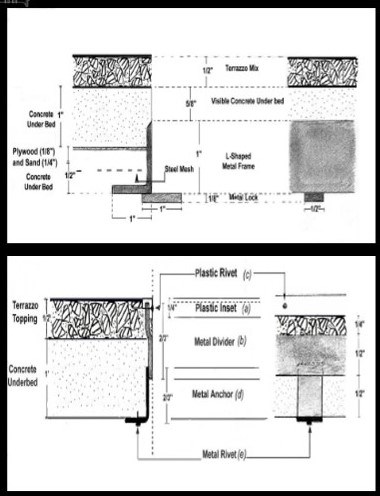
Materials
The terrazzo pavement at the New York State Pavilion was an innovation at the time of its production as it was the first project to incorporate glass aggregates and plastic insets. Material analysis of the pavement was important in selecting conservation treatments. Samples of the plain (grey) and colored terrazzo were analyzed using optical microscopy and X-ray diffraction and were found to have an aggregate/paste ratio of 70% to 30% in the plain terrazzo and 60% to 40% in the pigmented terrazzo. The blue and red tinted terrazzo both contained glass aggregate while the grey and other colored areas utilized the more traditional crushed stone.
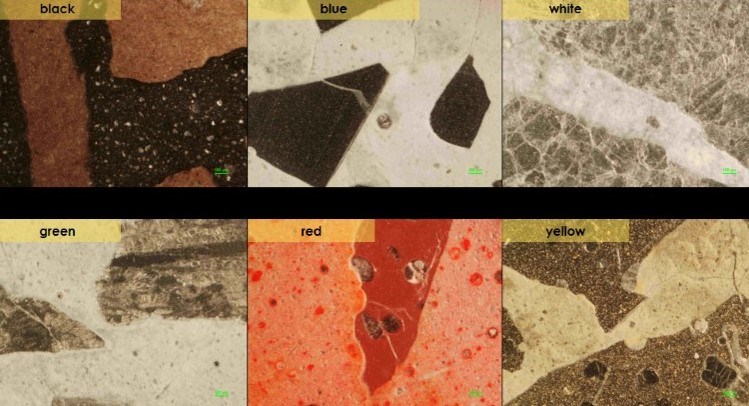
Through chemical spot testing and PXRF, it was found that the metal frame encasing the panel was tin-coated steel, while the dividers were made of tin-coated zinc. Tin-coated zinc strips held the plastic insets in place as well. The tin acted as an anti-corroding agent although tin itself corrodes rapidly in an alkali and acidic environment. Thin iron bars and expanded iron mesh were embedded in the under-bed for structural reinforcement.
The plastic insets were identified using Fourier Transform Infrared (FTIR) spectroscopy. The hand cut symbols and letters were made of polymethyl methacrylate, known under trade names such as Lucite™ or Plexiglas™, which is produced in stiff sheets making it easier to cut. The linear plastic insets were made of cellulose acetate butyrate, known as Butyrate™ and preferred for its ease of formability in creating the curved contours represented in the map. These plastics have very different properties, including reactivity to various solvents. The identification of the plastic insets was essential in understanding their original selection based on inherent properties needed during fabrication and in determining the safest cleaning techniques during conservation.
Existing Conditions
Deterioration of any material or construction system may be attributed to its composition, manufacture, installation, environment, and maintenance. The terrazzo floor map of the New York State Pavilion has undergone significant changes since its inception and its deterioration is a combination of all these factors listed above. The current conditions identified on the terrazzo pavement include loss, disaggregation, deformation, incipient spalling, and parallel and network cracking ranging from minor to severe. The deterioration of the pavement is also a result of its environment within the Pavilion and the changes that have occurred over the past forty years. The Tent of Tomorrow was always an open-air structure with a partial roof and an open oculus at the center, which would have protected most of the map from solar radiation and direct contact with rain and snow. The dismantling of the roof in the mid-1970s left the floor completely exposed to the elements. Poor drainage, extreme temperature changes, major vegetation, lack of maintenance, and vandalism have all contributed to the deterioration of the pavement.
An assessment of the entire pavement based on location and severity of conditions was an important part of understanding the patterns of decay and quantifying the number of tiles in various states of condition. Two condition surveys were completed in 2007, an overall assessment of every tile of the map and a detailed assessment of the tiles that make up the Long Island portion of the pavement for the pilot conservation project.
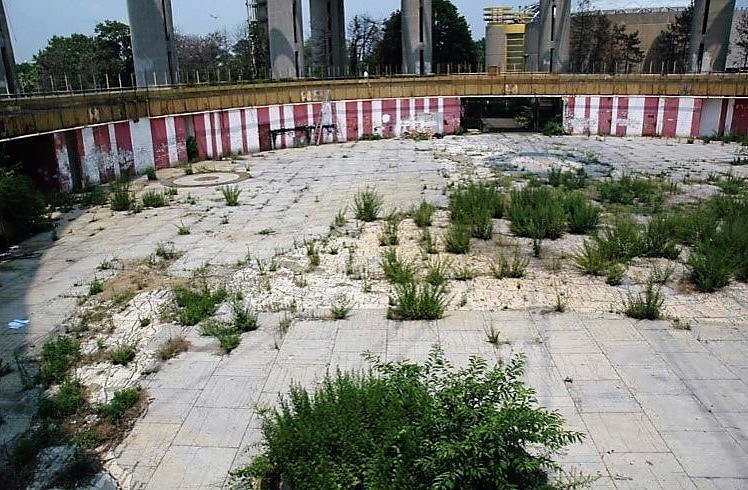
Condition Survey and Assessment: Methodology
A detailed ortho-rectified photographic plan of the pavement was first produced by montaging 567 individual high-resolution digital photographs. Field recording time was greatly streamlined by building a lightweight rolling quadropod designed to capture the surface area of a single tile. An overall conditions survey was then prepared to rank each of the 567 tiles from 1 to 10, with 1 representing the worst condition and 10 representing the best condition. By giving a numerical value and corresponding color to each tile, individual tile conditions could be easily classified and spatially located across the entire pavement. The initial survey was done by hand in the field and then transferred into Arc View (ArcGIS) for quantification which facilitated future tracking of conditions and treatments.

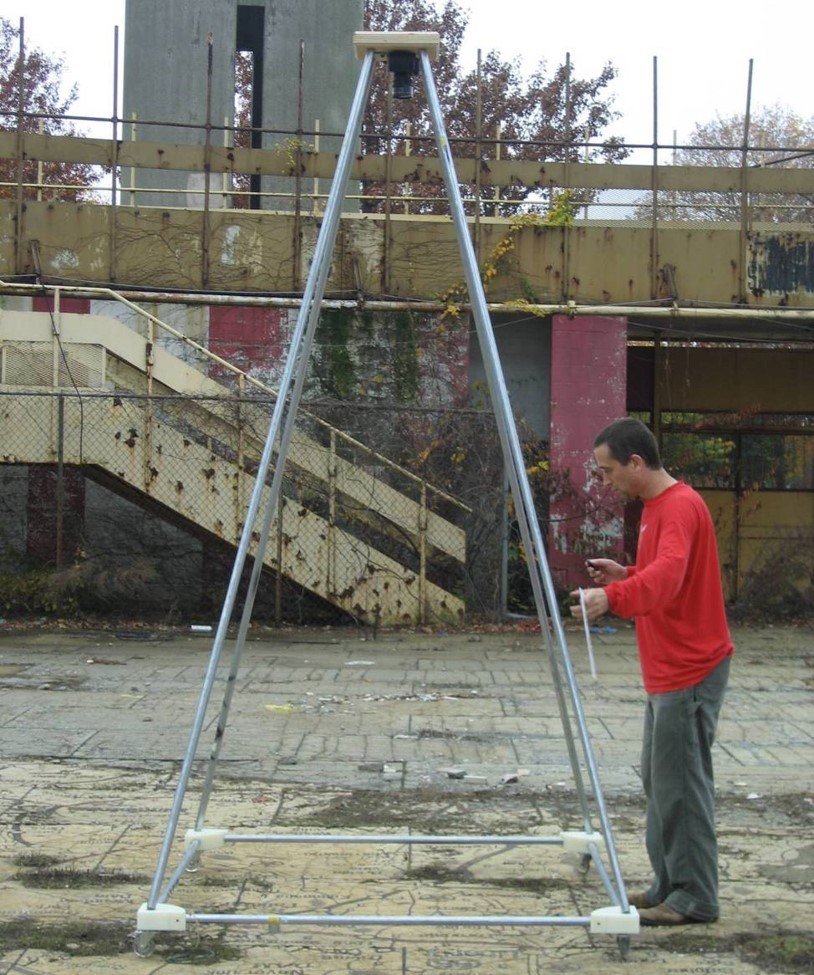
The condition rating assigned to each tile was based on an overall assessment of the tile condition rather than an average of separately rated factors. The overall assessment of the condition of each tile considered the degree of cracking, deformation, and integrity (i.e., presence or lack of original material). A high value reflected a higher integrity and quantity of original fabric and a low percentage or area of loss. Condition was rated on a scale of 0-10. No tiles were given a value of 10. A value of 0 indicates a tile that was completely replaced by cement.
Three broad categories (good, fair, and poor) were created to better understand and visualize the extent of the deterioration of the pavement. The survey reflects the range of conditions of the tiles and the approximate percentage of loss. Tiles given a value of 6-9 display a range of approximately 0-10% loss (good condition); tiles with a value of 3-5 display approximately 10-30% loss (fair condition), and tiles with a value of 0-2 display approximately 30-100 % loss (poor condition), including those that have been replaced by concrete. Tiles in good condition made up 59% of the map; those in fair condition made up 29%; and tiles in poor condition, including those with no data recorded made up 12%. This suggests that more than half the pavement is in sound condition with less than 10% loss.
Condition Assessment
The condition of the tiles can be directly correlated (in order of significance) to their design, fabrication, and location in the Pavilion. The tiles in best condition are located in the east and south portions of the pavement. The tiles in the worst condition are present in two horizontal bands across the center and upper portion of the state or clustered around the tiles that have been entirely replaced. The tiles rated in fair condition are more evenly distributed and display no particular pattern.
The prevalence of specific conditions within individual tiles appears to be due to the design and fabrication of the tiles rather than floor location. While it is difficult to determine if tiles with a higher density of insets and individually bound sections display more damage, it is clear that the configuration of the insets defines the pattern of cracking. In most cases, cracking is perpendicular to the insets or in the case of the plain grey terrazzo tiles, occurs in parallel patterns, reflecting the ferrous reinforcement rods within. Although these rods were also used in the figural tiles, the insets disrupt the number and placement of the bars as well as the severity of cracking. Map cracking, a natural phenomenon in all paste-aggregate systems, is worsened by water infiltration and subsequent freeze-thaw, salt cycling, and the growth of disruptive vegetation. Paste shrinkage around Insets provides ready-made entry points for water and depending on the size of the terrazzo section, cracking will eventually lead to spalling and loss. The blue and red terrazzo appear to display the worst cracking and disaggregation conditions, which may be due in part to the use of a glass aggregate and the narrowness of these features (e.g., roads and rivers). Petrographic examination reveals these colors to have poor interface bonding between the paste and aggregate, which may be the cause of excessive disaggregation, although no alkali silica reaction (ASR) was observed, and their brittleness would explain cracking and spalling in these sections.
Loss is also observed in letters or symbols that have become dislodged from the terrazzo through cracking, disaggregation, and theft. Concave deformation is observed on most tiles whereby the center slumps and the edges rise. This is probably due to a combination of mechanisms including thermal expansion of the terrazzo surface and metal frame (expected and accommodated partially by the original gasket) and rot and loss of the plywood support. The overall effect is water pooling in the center of many tiles and degraded tile perimeters characterized by loss of terrazzo and insets.
Informing a Methodology for Treatment
Four tiles from Long Island were selected for pilot conservation treatment to develop methods and cost estimates for the entire pavement. The tiles and their conservation were the centerpiece of an exhibition on the Pavilion and the pavement at the Queens Museum of Art in spring 2008. (For a version of the virtual exhibition see www.thereallybigmap.com).Treatments were first researched and tested on one tile, and then adjusted for the remaining three to both improve techniques and demonstrate visual variations in compensation. Treatments were divided into two major categories: those addressing the structural support of the tile, and those addressing the terrazzo surface – the design layer with its insets. The goals for conservation were to preserve as much of the original fabric as possible, to communicate the original design of each tile by reintegrating areas of loss, to make all of the repairs discernable while emphasizing the legibility of the map features, and to use materials that were compatible with the original materials and produced the least amount of waste and toxicity to the environment and those executing the conservation work.
The conservation of the four terrazzo tiles provided a range of challenges and an opportunities to develop a standard for treatments that could address the unique needs of each tile, while remaining flexible enough to adjust them when necessary. By the time the last tile was conserved, a list of materials and techniques had been chosen that successfully achieved the goals that were specified at the outset and could be implemented repeatedly on a large scale. The following summary outlines the materials and methods that were ultimately selected for use as the preferred treatment.
Emergency Stabilization
The first step after documenting each tile in situ, was to face their surface both before and if necessary, after transfer from the site. The facing materials that proved the most successful and appropriate in terms of their ability to adhere to the terrazzo surface and the ease with which they could be removed later, were methylcellulose and cotton gauze. Using 4” wide strips, overlapped in 3 layers, achieved the greatest strength. Double facing the edges of the tile offered additional strength to areas that were frequently damaged and susceptible to movement. Once stabilized, tiles could be crated and removed off site using a specially designed “rake” to slide the tiles apart parallel to the ground.
Preparation of Structural Support: Sacrificial Plaster Fills
Initially a plaster pour was made over the faced surface to protect the tile and its fragments from movement. The disadvantage of this method was that the existing deformations in the terrazzo surface could not be reversed due to the restrictions of the rigid plaster pour during re-backing. The plaster pour was omitted for the remaining three tiles to allow the faced terrazzo surface to relax and be pressed flat once it was face down, mitigating the deformation. This technique proved successful and had the advantage of lessening the weight of the tile as well.
Structural Repair: Removal of the Original Support
The original cementitous underbed and ferrous rebars that were loose and deteriorated were easily removed by hand. Any underbed or metal reinforcement that was securely bonded to the terrazzo was left in place rather than risk damaging the terrazzo surface in their removal. Trial removals by chisel and grinder proved too damaging. Corroded reinforcement bars were left in place, mechanically cleaned, and epoxy coated.
Sacrificial Fills
Silicone rubber, plasticine and plaster were all used to temporarily fill losses. Silicone rubber had a few advantages and many disadvantages. It was easy to remove from the terrazzo and plastic insets, but the application was difficult to control because it was pourable and leaked into areas it was not intended to protect. It was also difficult to build up height, resulting in areas that were not deep enough for fills. To avoid this, the silicone was poured over an entire area, and once it cured, was cut back into the desired shape. This was not only time consuming but not very accurate. Additionally, the silicone was very expensive making it impractical on a large scale.
The plasticine clay was easy to apply and mold into any desired shape and could be inserted into very small cracks. The only disadvantage was that it was more difficult to remove from the underbed and terrazzo surface and required the use of dental picks and other small tools. It was nevertheless preferable to the silicone.
Plaster fills, although heavy, were successful at filling large voids (larger than 4-6” in diameter) and especially around the perimeter. Thin plastic film provided a good barrier between the plaster and terrazzo but made narrow voids difficult to fill. Plaster was eventually used only for areas larger than 4-6”in dimension, while sculptor’s clay and wax was reserved for smaller areas.
New Underbed Support
Once the sacrificial fills were in place and the surface was vacuumed of dust and debris, the new underbed support was applied. All microcracks in the underbed were first consolidated with a polyvinyl acrylic emulsion. A commercial self-leveling cementitous bedding mortar with the same emulsion admixture was selected for the new underbed in combination with a rigid honeycomb support. The new mortar backing was applied first as a slurry to the back of the existing underbed and terrazzo. This was then followed by a ¾” pour of bedding mortar. Polypropylene microfibers were added at 2% volume of the dry mortar mix to increase the tensile strength of the mortar matrix. It was important that the three steps were done in succession so that the surface was not allowed to dry out.
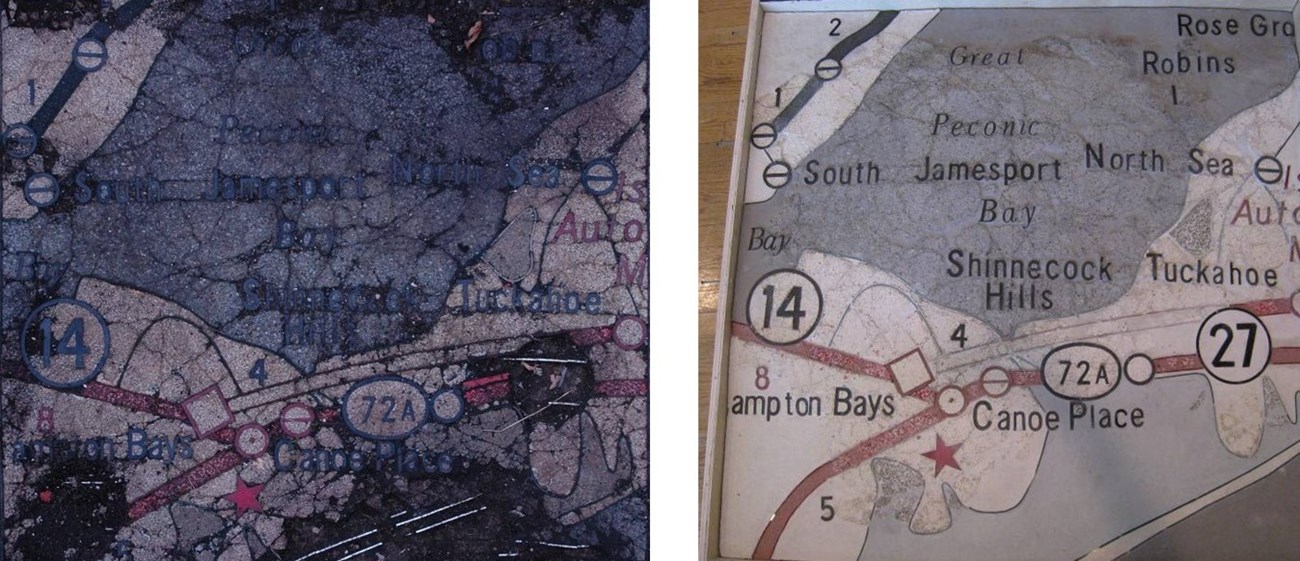
The Future
Given its immense scale and complexity, the great Texaco road map pavement will require ingenuity and funds in phasing its conservation. No doubt successful reuse and interpretation of the Pavilion including reinstatement of its roof will depend on the map’s continued presence on site. Removal and off-site treatment of the tiles, however, will facilitate the necessary structural work required on the Pavilion first as well as the installation of a new waterproof foundation for the floor. Display techniques will need to strike a compromise between usable floor area and the presentation of the map as an exhibit given its condition. In the meantime, designs for temporary reburial with sand, geomembrane and soil, commonly used for ancient mosaics, were prepared and the map has now been buried to protect it from further environmental damage and vandalism. Plans are now underway to restore and renovate the pavilion as public sentiment shifts in favor of preserving the last vestiges of the New York World’s Fair landscape. Meanwhile the pavement remains a hidden witness to the artistic and cultural revolution of the 1960s and the success of Johnson’s and Rockefeller’s pavilion.
The Pavilion and its map pavement remind us that the works of the not-so-distant past—once heralded as the future—are now today’s heritage. Our conservation philosophies and expertise are still somewhat undeveloped to sufficiently address the treatment and display of these more recent works of art and architecture, especially those designed to be temporary or discardable. Our tolerances and even expectations of age-value, compensation, and use are at once challenged by these works; however it will only be in the execution of projects in practice that we will better understand the value of the original and its weathering, as well as the role of facsimile and simulacra in the preservation of image and material.
Acknowledgements
This project would not have been possible without the generous funding from the National Endowment for the Arts, the Samuel H. Kress Foundation, and the World Monuments Fund. The authors are grateful to these institutions for recognizing the significance of the New York State Pavilion as a new generation of historic landmarks and the importance of and desperate need for its conservation. We are also grateful to the New York City Department of Parks and Recreation and the Queens Museum of Art for their support and collaboration and in particular to Commissioners Adrian Benepe, Amy Freitag, Estelle Cooper and Dorothy Lewandowski for encouraging the project throughout its development and execution. We would also like to thank the following for their assistance in preparing the exhibit: Charles Aybar, Gerald (Jerry) DeLazzaro, D. Lindsay Falck, Andy Looney, Gautam Malik, David Oats, John Pender, Alfredo Devido Architects, Caples Jefferson Architects, National Geographic Society, the National Terrazzo and Mosaic Association, Port Morris Tile and Marble Corporation, Richard Payne Photography, Megan Cross Schmitt, Scott Frances Photography, Susan Singh, and Monica Wyatt.
Endnotes
- http://www.conlab.org/acl/nysp/index.html
- Pop art is considered one of the major art movements of the twentieth century, which originated in England in the mid-1950s and appeared in the United States shortly there-after. Aiming to bridge the growing gap between main-stream public and high-brow art world, Pop art brought art back to the masses through familiar imagery. Pop art is typically characterized by themes taken from popular culture outlets such as billboards, comic strips, and advertisements and often contained elements of kitsch. Pop artists were also known to challenge the role of traditional art techniques by employing mechanization and commercial art techniques. The works were often oversized and exaggerated. With the introduction of Pop art came a new relationship between artist, audience, and art. Now the audience was responsible for understanding how the Pop artists were simultaneously acknowledging, celebrating, and condemning popular consumer culture.
- Amel Chabbi, Restoring a 20th Century Terrazzo Pavement: A Conservation Study of the Floor Map of the New York State Pavilion, Queens, New York, Master’s thesis, University of Pennsylvania, 2004. Susan Singh, Complexities in Conservation of a Temporary Post-War Structure: The Case of Philip Johnson’s New York State Pavilion at the 1964-1965 World’s Fair, Master’s Thesis, University of Pennsylvania, 2004. Ann Thorkelson, An Approach to Conservation and Presentation of the Terrazzo Map Pavement of the New York State Pavilion in Queens, New York, Master’s Thesis, University of Pennsylvania, 2008.
- http://www.conlab.org/acl/gordion/mosaic.html
